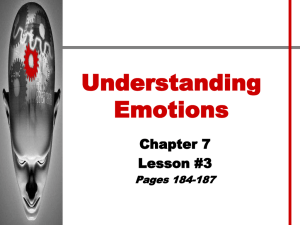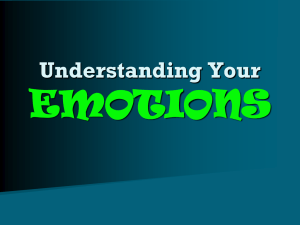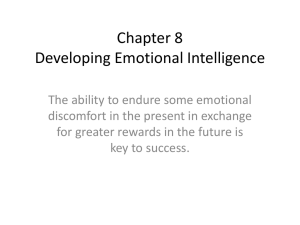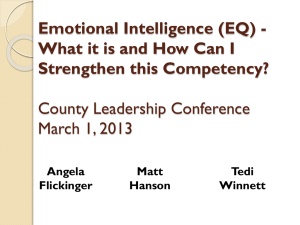academic emotions
advertisement
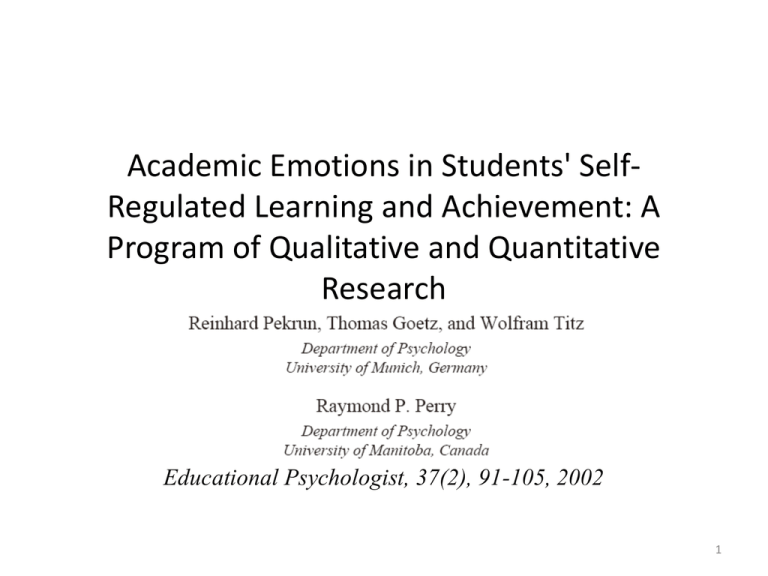
Academic Emotions in Students' SelfRegulated Learning and Achievement: A Program of Qualitative and Quantitative Research Fsfewfd Educational Psychologist, 37(2), 91-105, 2002 1 1. Introduction • Within the perspective of test anxiety and motivation research, we have found that test anxiety has been researched extensively since the beginning of the 1950s (Mandler & Sarason, 1952) and even prior to that (cf. Stengel, 1936), whereas students’ academic emotions, other than anxiety, have been largely neglected. • It appears that test anxiety has continued to attract researchers, whereas other achievement-related emotions have received much less attention. • This pertains to negative emotions other than just anxiety, but even more so to positive achievement-related emotions. 2 • For example (see Table 1), whereas more than 1,000 studies have addressed achievement-related anxiety to date, we were not able to locate more than 9 studies on the complementary emotion of students’ hope. • Also, there is a dearth of studies on students’ regulation of their emotions (cf. Schutz&Davis, 2000). 3 1. Introduction • Most studies were conducted from the perspective of specific traditions of research and addressed no more than one or two emotions, implying that a broader perspective on a range of emotions was largely lacking in much of the empirical research to date. • Academic learning and achievement are among the most important topics in our society today, especially because educational and professional careers, social relations, and the allocation of many kinds of resources are largely dependent on individual achievement. • This implies that learning and achievement are singularly important and thus major sources of human emotions today, instigating a variety of self-referenced, task-related, and social emotions (cf. also Scherer, Wallbott, & Summerfield, 1986). 4 1. Introduction • We propose to use the term academic emotions to denote such emotions. By defining academic emotions in this way, the term academic is used as is commonly done with terms such as academic motivation or academic self-concept. • In doing so, the domain of academic emotions would include students’ achievement emotions experienced in school or university settings, but goes beyond emotions relating to success and failure by also covering, for example, emotions relating to instruction or to the process of studying (see Table 2). 5 6 1. Introduction • The following research questions guided our studies on academic emotions: 1. Which emotions do students experience in academic settings when attending class, studying, and taking tests and exams? Furthermore, what are the elements of these emotional experiences and how are they structured? 2. How can we measure students’ academic emotions? 3. How do these emotions affect learning, academic achievement, and students’ health? 4. What are the origins of these emotions within students’ personality and in their environments? 5. What can we do to foster positive academic emotions and to help students avoid negative emotions, or to cope with negative emotions in flexible ways once they emerge? 7 1. Introduction • In the following, we give an overview of our research pertaining to these questions. Specifically, in the sections of this article we address the following parts of our research in turn: 1. In a series of qualitative case studies, we explored the occurrence and phenomenological structures of academic emotions. 2. Based on our exploratory evidence, we developed a quantitative self-report instrument measuring nine academic emotions experienced by students (the Academic Emotions Questionnaire [AEQ]). 8 1. Introduction 3. In a number of quantitative studies using the AEQ, we tested assumptions underlying Pekrun’s (1992) cognitivemotivational model concerning the effects of emotions on students’ self-regulated learning and achievement. 4. Finally, we developed and tested a social cognitive, control– value theory on the individual academic emotions. 9 2. Exploring the occurrence and structures of academic emotions: Qualitative case studies • We analyzed the emotions of school and university students by means of qualitative interviews and questionnaires. • We asked our participants about their emotional experiences in academic settings when in class, studying, and taking tests and exams. • In the first study, students were asked to recall typical academic episodes from their autobiographical memories and to report the emotions experienced within these episodes (Pekrun, 1992c). 10 2. Exploring the occurrence and structures of academic emotions: Qualitative case studies • The other four studies used a more situated approach by interviewing participants immediately after classroom instruction, an exam, or a daily period of studying (cf. Spangler, Pekrun, Kramer,&Hofmann, in press; Titz, 2001). 11 2.1 Frequencies of Different Emotions • In accordance with theoretical expectations, the results of the five studies showed that students experience a wide range of emotions in academic settings. • Emotional diversity implies that theory-driven approaches to students’ emotions that limit the range of emotions considered for theoretical reasons may be in danger of missing important parts of students’ affective life. • Different categories of discrete emotions appeared with differing frequencies, depending in part on the type of academic situation addressed. 12 2.1 Frequencies of Different Emotions • Overall, anxiety was the one emotion reported most often, accounting for 15% to 25% of all emotions reported in our studies. • However, despite the frequency of reports about anxiety, positive emotions were described about as often as negative emotions. • Aside from anxiety, emotions reported most often were enjoyment of learning, hope, pride, and relief, as well as anger, boredom, and shame. 13 2.2 Tracing Unexpected Phenomena • A case in point was students’ meta-emotions, that is, their feelings about their own emotions. For example, a number of students gave detailed accounts of experiencing anger about being anxious before exams. • This anger helped them to find ways to cope with the anxiety, something educators may wish to consider when trying to assist students in dealing with their affective experiences. • An example pertaining to the sources of academic emotions is our participants’ reports about academic boredom. (1) When self-evaluations of abilities were high and instructional demands low, students reported that they felt bored and daydreamed. (2) when feeling unable to keep up with demands, implying that boredom was connected to low self-evaluations of abilities and high evaluations of demands. 14 2.3 Constructing Taxonomies of the Internal Structures of Academic Emotions • Many of cognitive components were reported as relating to more than one emotion. In a similar vein, some other types of components were also shared by several emotions. • This would suggest some overlap among different emotions, as in the case of worries about failure that were reported as being part of exam-related anxiety but also as components of shame and hopelessness. • One general implication is that it may be difficult to measure different emotions in non-overlapping ways, making it difficult to ensure discriminant validity of these measures. 15 2.3 Constructing Taxonomies of the Internal Structures of Academic Emotions • In this regard, contemporary test anxiety scales containing worry items (cf. Hodapp & Benson, 1997; Sarason, 1984) may measure shame or hopelessness in addition to anxiety, thus making it necessary to reinterpret much of the empirical evidence gathered using them. 16 2.4 Academic Emotions and Physiological Activation • It is interesting that measures of emotional intensity based on our participants’ qualitative reports about their emotions experienced during an important exam were systematically related to cortisol levels before and after the exam, whereas questionnaire-based measures showed a much less consistent pattern. • This evidence suggests that qualitative reports may prove useful even for studying functional relations between subjective and physiological levels of emotions. 17 3. Quantitative measurement: The AEQ • Whereas qualitative methods may be ideally suited to explore new fields, quantitative measures are needed for more rigorous tests of hypotheses. • Previous research on academic emotions beyond anxiety used general measures of emotions not tailored to the academic domain (Weiner, 1985) . • Measures of general emotions, however, are removed from the academic domain and probably less predictive for academic achievement than more domain-specific scales. For example, general trait anxiety correlates less with students’ achievement than their test anxiety (Hembree, 1988). 18 3. Quantitative measurement: The AEQ • We therefore attempted to develop a multidimensional instrument that measures a number of more important academic emotions in domain-specific ways, using multiple items for each emotion to represent different components of these emotions. 19 3.1 Theoretical considerations guiding scale development • We decided to develop scales for a limited set of emotions that may be important in many academic situations and that can be assumed to affect students’ learning, achievement. • Specifically, we used three criteria in creating this set of emotions : (a) Categories of primary human emotions that play a role in academic settings—According to our exploratory data, this is true of joy, anger, anxiety, and shame, as well as hopelessness, (b) Eight emotions reported frequently by students in our exploratory studies, (c) we wanted to include positive and negative emotions, as well as both activating and deactivating emotions within these categories. 20 3.1 Theoretical considerations guiding scale development • The resulting set of emotions contains the positive emotions of enjoyment, hope, and pride (positive activating), as well as relief (positive deactivating), and the negative emotions of anger, anxiety, and shame (negative activating), as well as hopelessness and boredom (negative deactivating). • Regarding academic situations, being in class, studying outside of class, and taking exams are the three most important types of academic situations at school and university. 21 3.1 Theoretical considerations guiding scale development • These situations are characterized by different functions and social structures, implying that emotions relating to them may differ as well. - For example, enjoyment of classroom instruction may be quite different from enjoying the challenge of an exam. • We therefore decided to develop separate scales pertaining to class-related, learning-related, and test-related emotions. 22 3.2 Item statistics, reliabilities, and structures of scales • Table 3 presents item numbers and internal reliabilities for the trait versions of the AEQ scales. Reliabilities are based on two samples of university students (learning-related and class-related emotion scales: N = 230; test emotion scales: N = 222). Coefficients imply that internal reliabilities are quite satisfactory. • Average reliabilities of the scales of the short trait versions, the course-related versions, and the state versions were = .87, .86, and .87, respectively. 23 4. The impact of academic emotions on self-regulated learning and achievement: Testing assumptions of a cognitive-motivational model • Emotions serve the functions of preparing and sustaining reactions to important events and states (1) by providing motivational and physiological energy, (2) by focusing attention and modulating thinking, and (3) by triggering action-related wishes and intentions. • This would imply that emotions can profoundly affect students’ thoughts, motivation, and action. However, empirical evidence is limited to date. • We used findings from experimental mood studies and test anxiety research to deduce hypotheses on the impact of academic emotions. 24 4.1 Previous research • Positive mood may facilitate holistic, intuitive, and creative ways of solving problems, as well as an optimistic reliance on generalized knowledge structures (e.g., Bless et al., 1996). In contrast, negative mood may enhance more focused, detailoriented, analytical, and algorithmic modes of processing information. • Finally, it has been shown that mood may produce task-irrelevant thinking that may be detrimental for task performance (Ellis & Ashbrook, 1988; Meinhardt & Pekrun, in press). 25 4.2 A cognitive-motivational model on the effects of emotions • Using these two dimensions, four groups of emotions in general, and of academic emotions in particular, may be distinguished with reference to their performance effects: (a) positive activating emotions (such as enjoyment of learning, hope for success, or pride); (b) positive deactivating emotions (e.g., relief, relaxation after success, contentment); (c) negative activating emotions (such as anger, anxiety, and shame); (d) negative deactivating emotions (e.g., boredom, hopelessness). 26 4.2 A cognitive-motivational model on the effects of emotions • In line with the findings of mood and test anxiety research, the model assumes that mediating mechanisms and resulting academic achievement are influenced by these categories of emotions as follows. - Motivation - Strategies for learning - Cognitive resources - Self-regulation - Academic achievement 27 - Motivation • Emotions may trigger, sustain, or reduce academic motivation and related volitional processes. • In this way, positive activating emotions such as enjoyment of learning may generally enhance academic motivation, whereas negative deactivating emotions may just be detrimental (e.g., hopelessness, boredom). • Positive emotions such as relief or relaxation can deactivate any immediate motivation to continue academic work, thus facilitating disengagement. 28 - Motivation • The effects of negative activating emotions may be even more ambivalent. Anger, anxiety, and shame can be assumed to reduce intrinsic motivation, because negative emotions tend to be incompatible with enjoyment as implied by interest and intrinsic motivation. • For example, task-related anger may be assumed to trigger motivation to overcome obstacles (cf. also Bandura & Cervone, 1983), and anxiety and shame may induce motivation to avoid failures by investing effort, thus strengthening academic motivation. 29 - Strategies for learning • Positive academic emotions facilitate the use of flexible, creative learning strategies such as elaboration, organization, critical evaluation, and metacognitive monitoring. • Negative emotions, on the other hand, may trigger the use of more rigid strategies, such as simple rehearsal and reliance on algorithmic procedures. 30 - Cognitive resources • Emotions serve functions of directing attention toward the object of emotion, implying that they use cognitive resources and can distract attention away from tasks. • Emotions such as enjoyment, pride, admiration, anxiety, anger, or envy can relate to the setting, other persons, or the self, thus producing task-irrelevant thinking, reducing cognitive resources available for task purposes, and impairing academic achievement. 31 - Self-regulation v.s External regulation of learning • Self-regulation of learning implies planning, monitoring, and evaluating one’s own learning in flexible ways and adapting learning strategies to task demands and the progress made. It may be speculated that it is facilitated by positive emotions. • Negative emotions, on the other hand, may be assumed to motivate students to rely on external guidance. 32 - Academic achievement • Emotion effects on students’ achievement may depend on the interplay between these different motivational and cognitive mechanisms of self-regulation and on interactions between these mechanisms and task demands. • This implies that emotion effects on academic achievement will inevitably be complex and overdetermined. • Nevertheless, a number of general assumptions can be deduced from the preceding hypotheses. 33 4.3 Empirical Findings • Table 4 shows exemplary correlations between major trait learning-related emotions and components of self-regulated learning in a sample of 230 university students (Titz, 2001, Study 2). Intrinsic motivation Extrinsic motivation ++ ++ -+ -+ -- Positive activating(++) negative activating(-+) positive deactivating (+-) negative deactivating (--) 34 4.3 Empirical Findings – Motivation and effort • In contrast, the negative deactivating emotions of boredom and hopelessness correlated negatively with all of these motivational variables and with self-reported effort (cf. Table 4), thus suggesting that these two emotions may be detrimental for students’ academic motivation. • Concerning the activating emotions of anger, anxiety, and shame, average correlations were negative as well. • However, correlations for these emotions were lower, and in some of our studies, the coefficients for anxiety and self-reported Intrinsic motivation motivation academic effortExtrinsic were essentially zero (cf. Pekrun & Hofmann, 1999). • For example, it turned out that students’ anxiety correlated ++ negatively with intrinsic as well as overall extrinsic motivation but ++ -+ positively with extrinsic avoidance motivation (i.e., motivation to -+ invest effort to avoid failures; Pekrun & Hofmann, 1999). -Positive activating(++) negative activating(-+) positive deactivating (+-) negative deactivating (--) 35 • However, correlations for these emotions were lower, and in some of our studies, the coefficients for anxiety and self-reported academic effort were essentially zero (-.19) (cf. Pekrun & Hofmann, 1999). • For example, it turned out that students’ anxiety correlated negatively with intrinsic as well as overall extrinsic motivation but positively with extrinsic avoidance motivation (i.e., motivation to invest effort to avoid failures; Pekrun & Hofmann, 1999). Intrinsic motivation Extrinsic motivation ++ ++ -+ -+ -- Positive activating(++) negative activating(-+) positive deactivating (+-) negative deactivating (--) 36 4.3 Empirical Findings – Learning strategies • Positive emotions related positively to metacognitive strategies, elaboration, organization, and critical thinking, thus suggesting that positive academic emotions may in fact facilitate flexible, creative modes of thinking. • Relations between negative emotions and flexible learning strategies were negative but weaker and less consistent. • Concerning more rigid ways of learning, most of the correlations with rehearsal strategies were near zero for both positive and negative emotions (cf. Table 4). Intrinsic motivation Extrinsic motivation ++ ++ -+ -+ -- Positive activating(++) negative activating(-+) positive deactivating (+-) negative deactivating (--) 37 4.3 Empirical Findings – Cognitive resources • Negative emotions, on the other hand, correlated positively with task-irrelevant thinking. In test anxiety research, irrelevant thinking has often been defined as a component of this specific emotion (cf. Hodapp&Benson, 1997). • The findings of our studies suggest that relations of other negative emotions to irrelevant thinking are at least equally strong. Intrinsic motivation Extrinsic motivation ++ ++ -+ -+ -- Positive activating(++) negative activating(-+) positive deactivating (+-) negative deactivating (--) 38 4.3 Empirical Findings – Perceived self-regulation v.s External regulation • These findings suggest that positive emotions foster students’ self-regulation, whereas negative emotions lead to reliance on external guidance. Intrinsic motivation Extrinsic motivation ++ ++ -+ -+ -- Positive activating(++) negative activating(-+) positive deactivating (+-) negative deactivating (--) 39 5. Conclusion • The findings presented in this article demonstrate that students’ academic emotions are often multifaceted, can be measured in reliable ways by the AEQ self-report scales, and relate significantly to students’ learning, self-regulation, achievement. 40 5.1 Emotions and students’ self-regulation at learning and achievement • Emotions seem to be closely intertwined with essential components of students’ self-regulated learning such as interest, motivation, strategies of learning, and internal versus external control of regulation. • Gaining a realistic account of students’ competences for selfregulation and academic performance may require taking their emotions into account. • In so doing, simplistic conceptions of negative emotions as bad and positive emotions as being good should be avoided because positive emotions are sometimes detrimental and negative emotions such as anxiety and shame beneficial. 41 5.2 Affective educational psychology: Acknowledging emotional diversity • Judging from the results of our qualitative case studies, positive emotions such as enjoyment of learning, hope, pride, admiration, appear to be no less representative of this diversity than negative emotions. • To date, research on students’ affective life has focused on test anxiety and has generally been biased toward negative emotions. 42 5.3 Affective educational psychology: Acknowledging emotional diversity • To obtain a more complete picture of students’ academic reality, it would seem necessary to analyze their positive experiences as well (cf. also Fredrickson, 2001). • In so doing, it might profit anew from taking up broader perspectives on emotional diversity as implied. 43



